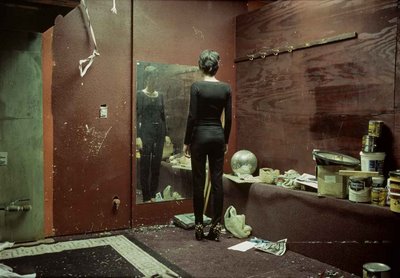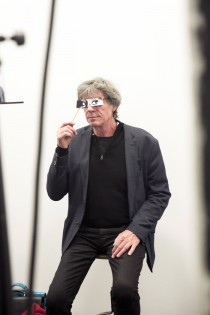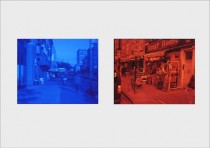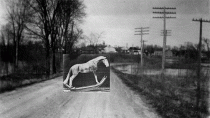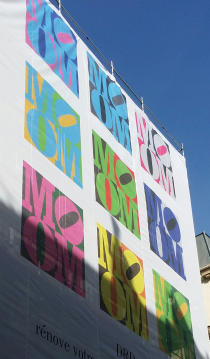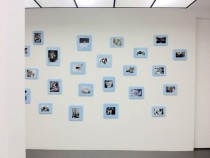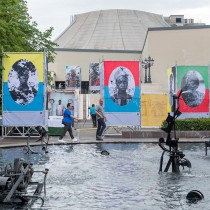TEXTE D’EXPOSITION X Lise Sarfati – by Romaric Tisserand
|
TEXTE D’EXPOSITION & COORDINATION / PRESENTATION DU FASHION MAGAZINE (English version below)
Lise Sarfati, Selina 01, Austin TX, 2008, courtesy Galerie BrancoliniGrimaldi / Roma
Lise Sarfati, Eva-Claire 02, Austin TX, 2008, courtesy Galerie BrancoliniGrimaldi / Roma
Lise Sarfati, Jennifer 01, Austin TX, 2008, courtesy Galerie BrancoliniGrimaldi / Roma
LISE SARFATI – Austin, Texas– Cette nouvelle série de Lise Sarfati a été réalisée en 2008 dans la continuité de sa grande trilogie sur les Etats-Unis débutée avec la série The New Life éditée par Twin Palms en 2005, puis poursuivie avec les séries Immaculate et She qui seront publiées cette année, respectivement chez Steidel Mack et en porfolio dans Aperture magazine. La série Austin, Texas a fait l’objet d’une publi cation en octobre 2008 par Magnum Publisher intitulé Lise Sarfati, Fashion Magazine. LE DOCUMENT FICTIONNEL Dans son travail, Lise Sarfati ne sépare jamais le documentaire de la fiction. Le choix de la ville d’Austin au Texas n’a rien d’anodin : Austin est à la fois le centre géographique de l’Amérique mais également le centre de la culture rock et underground. Austin, Texas présente des personnages d’adolescentes évoluant dans un environnement familier, celui d’Austin avec ses maisons en bois, ses intérieurs, ses rues, ses couleurs douces. L’ESPACE ET LE CORPS Lise Sarfati s’intéresse au thème du rapport entre le corps et l’espace. C’est cette interaction permanente des personnages avec l’espace qui structure sa démarche. Elle ne parle pas de portraits mais « d’études » de figures. Quentin Bajac, conservateur en chef du Cabinet de la Photographie du Centre Pompidou, décrit très bien ce phénomène : « Toutes ces jeunes filles sont à la fois dans l’ici de la prise de vue et dans un ailleurs indéfinissable. Cette ubiquité fondamentale est, à mon sens, à la source de l’intérêt que Lise Sarfati porte à ses jeunes modèles. […] Chacune de ses images enregistre littéralement la distance d’un corps à l’espace qui l’entoure et, ce faisant, construit de manière métaphorique, et très consciente, un rapport du modèle au monde qui l’entoure. » (1) NARRATIVE FASHION Naïves et brutales, sorties tout droit d’un roman et d’une puissante sensualité, affalées dans le fauteuil du salon familial – ou bien déambulant dans les rues d’un possible Eden texan, ces jeunes femmes n’ont pas de but revendiqué, ni d’action avouée à leur errance. “ Le modèle semble toujours avoir pris part au choix du vêtement selon une logique de vraisemblance ; chaque jeune femme choisit son personnage et s’y projette mais reste pleinement en accord avec le contexte et le décor qui est le sien, comme elle participe pleinement à la mise en scène de l’image finale. […] Le changement induit par le vêtement n’a donc rien d’une métamorphose. Parfois il est même imperceptible. Dans tous les cas, le vêtement ne fait jamais figure d’un déguisement sous lequel le modèle disparaîtrait.”(Quentin Bajac “Life Stills”)(2) L’ADOLESCENCE PERPÉTUELLE De ses lectures, Lise Sarfati gardera profondément ancré dans sa démarche, le concept littéraire de l’immaturité permanente de l’écrivain Witold Gombrowicz, dont elle retient de son œuvre majeure, Ferdydurke : « la jeunesse n’était pas chez elle un âge de transition : pour une moderne, elle représentait la seule période véritable de l’existence». Quentin Bajac explique encore très clairement cet apport fondamental dans la démarche de la photographe : « Elle aime citer Gombrowicz et l’attachement de ce dernier à la notion d’immaturité : la révolte sourde, le refus muet, le jeu avec la vie et la réalité, et surtout l’idée d’un sujet informe à la fois malléable et pourtant insaisissable qui finira toujours par se dérober. »(3) Et à Lise Sarfati ensuite de commenter à Rick Owens dans un autre entretien du Fashion Magazine : « Ce n’est pas le côté social de l’adolescent américain qui m’intéresse, plutôt l’adolescence d’un point de vue générique, comme une métaphore, une transition, un miroir. » LE ROMAN QUOTIDIEN Cet apport incontestable de « l’œuvre littéraire » a forgé sa perception et sa pratique photographiques et lui donnera un goût prononcé pour la narration. Lise Sarfati s’intéresse à l’histoire sans héroïsme d’adolescents des villes de province aux Etats-Unis. Chaque série est une histoire transversale, chaque série évoque une nouvelle qui nous plonge dans un imaginaire littéraire. Pour elle, l’esthétique photographique n’est pas construite par le regard – celui de l’artiste photographe – mais d’une accumulation d’expériences et de sensations qui génère un univers complexe, une histoire unique.
Romaric Tisserand Paris, Le 5 janvier 2009
Lise Sarfati est présente dans les grandes collections publiques incluant le San Francisco Museum of Modern Art, le Los Angeles County Museum of Art, le Brooklyn Museum of Art, le Philadelphia Museum of Art ainsi que la Bibliothèque Nationale de France. Son travail a été montré lors d’expositions monographiques au Musée FOAM d’Amsterdam, au DOmus Artium de Salamanque, à la Maison Européenne de la Photographie (MEP) ainsi qu’au Nicolaj Center of Photography Art à Copenhague. En 1996, elle a reçu le Prix Niepce à Paris ainsi que le Prix Infinity de l’International Center of Photography (ICP) de New-York. (1)(2)(3) Quentin Bajac, “Life Stills” extraits du Fashion Magazine Austin,Texas, octobre 2008, Magnum Publisher
(ENGLISH VERSION) LISE SARFATI – Austin,Texas- Lise Sarfati’s newest series, “Austin, Texas” was completed in 2008, as part of her trilogy on the United States which started with the series “The New Life”, published by Twin Palms in 2005 and continued with the series “Immaculate and She”, which will be published this year by Steidl Mack and as a portfolio in Aperture magazine. “Austin, Texas” was published in October 2008 by Magnum Publisher under the title “Lise Sarfati, Fashion Magazine”. THE FICTIONAL DOCUMENT In her work, Lise Sarfati makes no distinction between documentary and fiction. The choice of the city of Austin, Texas is anything but trivial: Austin is both the geographic center of the United States and the epicenter of the underground rock scene. The series presents teenage characters operating in a familiar environment: that of Austin, with its wooden houses, its interiors, its streets and its muted colors. SPACE AND THE BODY Lise Sarfati’s work focuses on the relationship between the body and space. It is this continuous interaction of the characters within their space which structures her approach. She does not refer to her work as portraiture, but as a “study” of figures. Quentin Bajac, Head of the Photography Department at the Museum of Modern Art, Centre Georges Pompidou, describes this phenomenon quite well: “All these girls are located in the ‘here and now’ of the picture and an indefinable elsewhere. This fundamental ubiquity is, to my mind, the reason for Sarfati’s interest in young models.[…] Each of these photos literally records the distance between a body and the space that surrounds it, and in that way, metaphorically (and this time very consciously) constructs a relationship between the model and the world around her.” (1) NARRATIVE FASHION Naïve and brutal, seemingly straight out of a novel, with powerful sensuality, reclined on an armchair in the family room, or roaming the streets of a possible Texan Eden, these young women have no purpose, no cause to fight, no clear action to explain their restless wandering. “The clothing always seems to have been chosen to match the model, and the logic is one of verisimilitude – each young woman projects a character she has chosen, but remains completely in harmony with her own natural context and setting. In accordance with Sarfati’s photographic maieutics, they’re full participants in the final photo’s mise en scène.[…] Thus the change induced by the closing has nothing in common with metamorphosis. It is even imperceptible sometimes. In any case, the clothing never seems to be a disguise under which the model disappears. (Quentin Bajac “Life Stills”)(2) PERPETUAL ADOLESCENCE Lise Sarfati’s approach is deeply rooted in the literary concept of permanent immaturity, described by writer Witold Gombrowicz. In his masterpiece Ferdydurke, the author states “youth was not for her a transitional period: for a modern person, it was the only period that was real in all of existence.” an idea Sarfati’s work continuously references. Quentin Bajac again eloquently explains this fundamental contribution to the photographer’s work : “She likes to cite Gombrowicz and his fondness for the concept of immaturity – a secret revolt, a silent refusal, a game played with life and reality, and especially the idea of a subject both malleable and yet elusive, who always, in the end, slips away.”(3) Lise Sarfati herself explains to Rick Owens in another interview on Fashion Magazine: “What interests me about American teenagers isn’t the social dimension. It’s adolescence from a more general view, as a metaphor, a transition, a mirror. » DAILY ROMANCES This undeniable contribution of literary work forged Sarfati’s perception and photographic practice, giving her a marked taste for storytelling. The artist is interested in the anti-heroic stories of teenagers from provincial cities in the USA. Each of the three series are a transverse story; each evoking a new story that plunges us into literary imaginings. For Sarfati, photographic aesthetics are not built by the photographer’s eye, but by an accumulation of experiences and sensations that create a complex world, a unique history. Romaric Tisserand Paris, 5th January 2009 Lise Sarfati’s work is included in numerous public collections including the San Francisco Museum of Modern Art, Los Angeles County Museum of Art, Brooklyn Museum of Art, the Philadelphia Museum of Art, and the Biblioteque Nationale de France in Paris. Her work has been featured in solo exhibitions at FOAM Amsterdam; the Domus Artium, Salamanca, Spain; Maison Européenne de la Photographie, Paris, France; and the Nicolaj Center of Contemporary Art, Copenhagen, Denmark. In 1996, the artist was awarded the Prix Niepce in Paris and the Infinity Award from the International Center of Photography (ICP) in New York.
(1)(2)(3) Quentin Bajac, “Life Stills” from Lise Sarfati Fashion Magazine Austin,Texas, october 2008, Magnum Publisher
|


